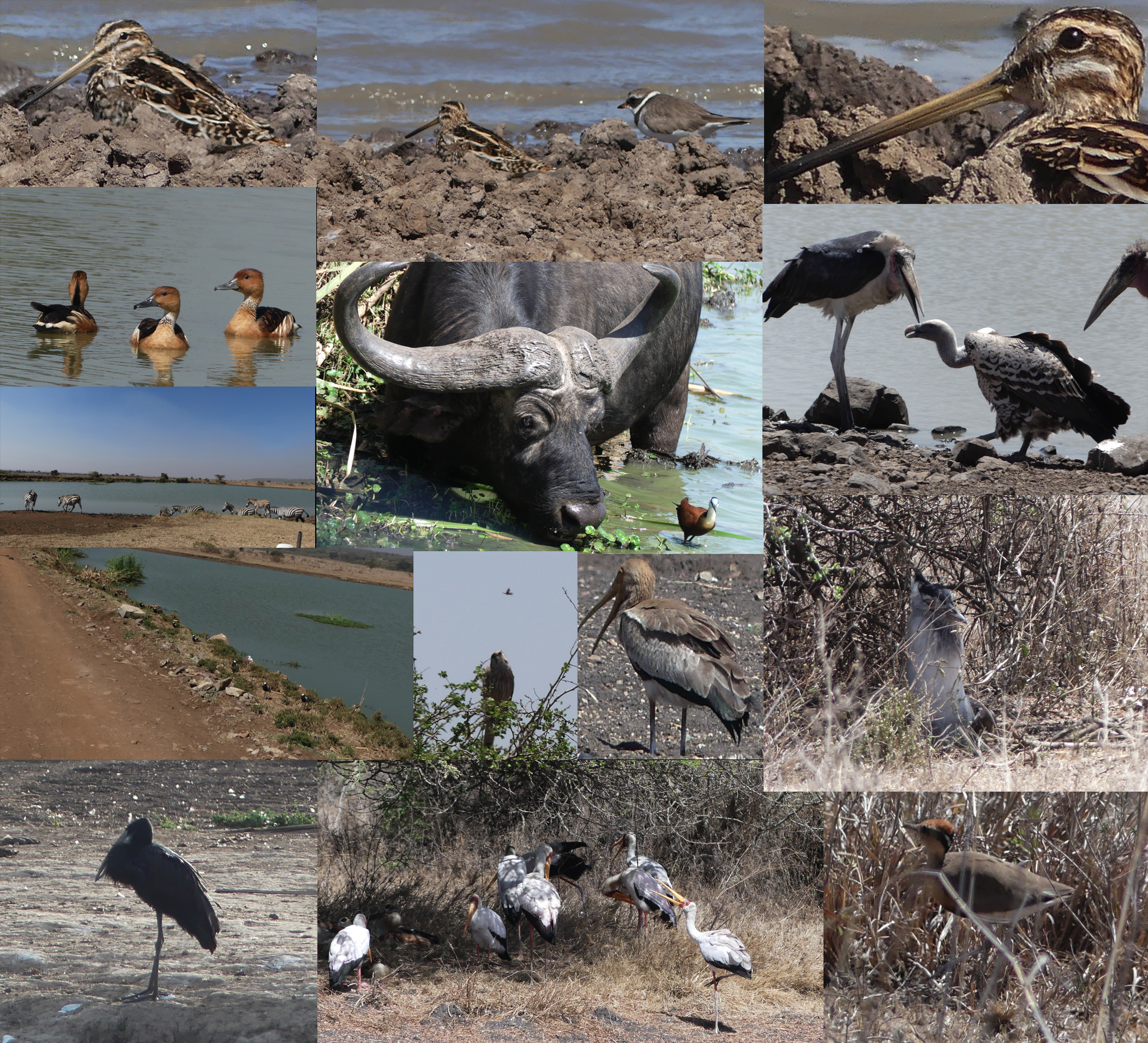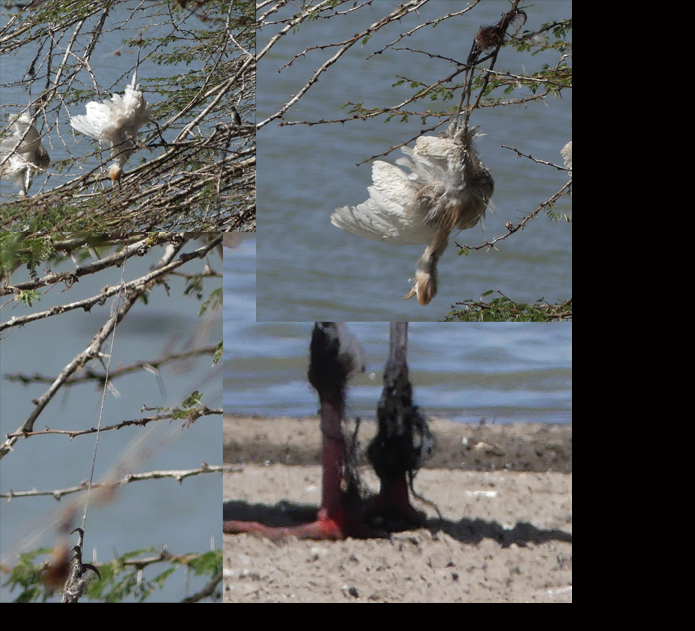From: Brian Finch <birdfinch@gmail.com>
Date: 2017-03-16 23:22
Subject: NAIROBI NATIONAL PARK 13th March 2017
NAIROBI NATIONAL PARK 13th March 2017
Dear All,
On Monday morning Karen Plumbe and Heather Elkins kindly picked me up
at 6.40am, and we headed off to NNP where we met Jennifer Oduore and
because we had cash still on our old Smart Cards we were through the
gate before 7.00am. There was no traffic, along both Magadi and
Langata Roads, it was amazing.
Apart from a pinking Nightingale on the drive in, the first bird was
the cheerful Zanzibar Sombre Greenbul. It was lightly overcast, but
not a drop of rain had fallen recently. Our first stop was Ivory
Burning Site, it seemed quiet when we arrived but in time a number of
good things appeared, the first of two female Western Marsh Harriers,
a female-type Montagu’s Harrier, the first of …six Isabelline Shrikes,
several Sand Martins and many Barn Swallows, a single House Martin,
and first of five Olivaceous and four Willow Warblers. On the Ivory
Burning Arena was the first of nine Isabelline Wheatears.
With nothing at the Nagalomon Drift, or the bridge we carried on to
the dam, with three White-faced Whistling Duck was a female
Knob-billed Duck, a good gathering of 15 African Spoonbills, one Great
Egret, four Darters including a displaying male, six or so
Black-winged Stilts, plus the usual resident plovers, a few Wood and
five Green Sandpipers which will soon be leaving us, an adult African
Jacana, and a bouncy Common Nightingale. Now taking the back road to
Hyena Dam we had a Yellow-billed Egret on the old marsh, where there
was the first of ten Yellow Wagtails consisting of just flava and
lutea. First of eight Whinchats, small flocks of Red-billed Queleas
with small numbers of White-winged and one Red-collared Widowbird male
in breeding plumage. There were also three Blue-eared Starlings
feeding along the fence line.
Hyena Dam had the water levels still dropping, the only reeds left now
being in the SW corner otherwise it is all open. Nevertheless it still
is an important wetland, and whilst there we had three Fulvous
Whistling-Duck, and a pair of Red-billed Teal, nine Yellow-billed
Storks, four African Spoonbills, an adult Fish Eagle, an African Water
Rail still holding out in spite of lack of habitat, as ridiculously
tame as ever, three Crowned Cranes, a staggering 45 Black-winged
Stilts, ten Long-toed and four Spur-winged Plovers, but along the
causeway we had to run the gauntlet of nineteen Blacksmith Plovers all
equidistantly spaced facing the roadside (see image). There were three
adult Jacanas, a Common Snipe, a Black-tailed Godwit (almost certainly
one of the pair a couple of weeks previously), one Marsh, four Green,
twenty Wood and three Common Sandpipers, a Ruff, and three Little
Stints. After our breakfast stop we continued our search.
Retracing to Nagalomon we took the paved road along the Mokoyeti,
there were an immature Martial Eagle, the first of just three
Red-tailed (Turkestan) Shrikes, and the first of just two Spotted
Flycatchers by the bridge. Down to its last water, Karen Primary
School Dam was not too interesting with just a pair of Red-billed
Teal, a couple of African Spoonbills, Eland Hollow was getting very
dry now but still produced a few of the commoner waders, a pair of
Crested Cranes and a Red-throated Pipit.
Taking the short cut to the East Gate Road there was a female Common
Kestrel on one bush, and near the road a male Kori Bustard was sitting
in the shade of a bush as it was now hot, and on the top of it was a
female Lesser Kestrel.
Crossing the plains was horribly unproductive, we picked up two
Black-shouldered Kites, a Gabar Goshawk, Tawny Eagle, a few Banded
Martin and first of two Pied Wheatears. A short detour to Empakasi Dam
was rewarding, with plenty of water it had now become the vulture
drinking area. There were nine Ruppell’s Vultures with several
White-backed. The Marabous were playing their usual game with vultures
of pecking when their head is under water (see image). Another four
African Spoonbills, three Yellow-billed Storks, seven White Storks and
a Great Egret were also present as well as the days first Greenshank.
Now heading to Athi Dam we found the days only Secretarybird, another
male Kori Bustard and a solitary Temminck’s Courser. At the dam it was
fairly busy with many Marabous dropping in as well as fifteen White
Storks and another seven Yellow-billed Storks and a similar number of
African Spoonbills (there must be many in the Park currently). Five
Black-crowned Night-Herons roosted on the causeway, a single
White-winged Black Tern patrolled the waters edge and an adult
Pink-backed Pelican on the bank. Two adult Fish Eagles sat tight in a
favourite tree, there were ten Black-winged Stilts and six Spur-winged
Plovers, seven Common Ringed Plovers were a good number, a very dark
and small Common Snipe in a most unlikely open setting (maybe my first
at Athi Dam- see image), one Marsh, five Wood and three Common
Sandpipers, a Greenshank, fifteen Little Stints and a Ruff. A dozen
Speckled Pigeons were feeding on seeding weeds, and the usual pair of
loringi Red-faced Crombecs were on the causeway with a male
non-breeding Lesser Masked Weaver. Also a sad situation regarding
Cattle Egrets there (see images).
It was now 4.30pm and has become tiresomely routine as we now had to
hurry to get out of the Park before 6.00pm or have the card blocked.
So no planned stops.
Just before the climb to Baboon Cliffs there were 31 White-backed
Vultures roosting in their usual trees, this is in addition to many
breeding pairs along the Mbagathi and other birds in much of the Park.
On the Mokoyeti crossing the other side of Baboon Cliffs was the days
only Long-tailed Cormorant, as we neared Nagalomon Dam a Saddle-billed
Stork was being harassed by a Tawny Eagle, or so we thought then the
Saddle-bill chased the Tawny Eagle after it had made a departure,
anyway it ended with them both going their separate ways, and the
final bird of the day was an adult Open-billed Stork at the dam.
We arrived at the gate with ten seconds to spare, and were duly
processed for the exit and whilst doing this picked up three common
species not seen the rest of the day in the Car Park.
It was a great day, not really a movement northwards as yet, none of
the non-wintering birds that spend the time south of Kenya were
recorded, and still no sign of a Sedge Warbler!
Mammals were in good numbers, the first Wildebeest are being born, and
we had new-borns with many mammals. Not far from Nagalomon Dam was the
first Common Duiker I have seen in NNP for quite some time. Baboon
Cliffs had a pair of honeymooning Lions, most plains game was either
around Hyena Dam, or Athi Dam as the grazing becomes scarcer every
day.
Best for now
Brian
KEY TO MONTAGE 1
ALL TOP ROW
COMMON SNIPE
This small dark-backed snipe at Athi Dam was very odd especially when
comparing size with Ringed Plover which looks the same size. But there
isn’t anything else that would rule out it just being an odd Common
Snipe.
SECOND ROW FAR LEFT
FULVOUS WHISTLING DUCKS
This handsome trio was on Hyena Dam, they are a rare visitor to NNP
SECOND ROW MIDDLE
Also at Hyena Dam this Buffalo seemed fascinated by the Jacana.
SECOND ROW FAR RIGHT
Marabous playing the traditional game of “Poke” with Ruppell’s Vulture
at Empakasi Dam.
THIRD ROW FAR LEFT
Just to show how little cover Hyena Dam has now, when it used to be
reeds all round and different water-plants over most of the surface.
FOURTH ROW FAR LEFT
BLACKSMITH PLOVER
Guarding the Hyena Causeway military fashion!
THIRD ROW MID-LEFT
LESSER KESTREL
This female is being bothered by a black hornet that was dive-bombing it.
THIRD ROW MID-RIGHT
YELLOW-BILLED STORK
This looks like the youngest individual I have ever seen in NNP, but
no speculations as to where it has come from as it can still probably
cover large distances.
THIRD ROW FAR RIGHT
KORI BUSTARD
This male could not have got further out of the hot sun if it tried,
it’s difficult to see how it has managed to get its body under the
bush and where it has put it!
BOTTOM ROW FAR LEFT
OPEN-BILLED STORK
This adult dropped in at Nagalomon Dam in the evening presumably to roost.
BOTTOM ROW MIDDLE
YELLOW-BILLED STORKS
Seven squeezing under a bush with Egyptian Geese for company, to get
out of the hot sun.
BOTTOM ROW FAR RIGHT
TEMMINCK’S COURSER
In the extensive dry plains now there could be many but this one was
above Athi Basin.
MONTAGE 2
For several years dangling Cattle Egrets have been a regular sight in
the large acacias along the Causeway at Hyena Dam. I have always
thought that they were inexperienced immature birds that had become
tangled in the thorns and barbs whilst roosting. During the day there
are usually no live Cattle Egrets at Athi Dam, but occasionally one or
two or more if following plains game coming to water. I had never
associated the birds with being ill but unfortunate accidents. Just
over a month ago Nate Dias reported in kenyabirdsnet of the dangling
egrets at Athi Dam, and thought it might have been relating to Avian
Flu.
On the 13th there were no less than 30 dangling egrets, but whereas in
the past they have always been on the waterside of the trees and
impossible to see well, on this occasion three were caught up over the
water but in gaps where they could be seen clearly.
On the images it shows the birds hanging, and includes adults as well
as immatures as can be seen from this bird in breeding plumage. For
the first time the cause for the macabre mystery could be seen, and
both Nate and myself were wrong. They are neither sick, nor are the
plumage and feet caught in the branches. Each bird has cord or
something like tangles of shredded plastic wrapped around their feet
and it is this that has caught in the branches and thorns leaving the
birds to an unpleasant death as they become exhausted and literally
fall off their perches.
It is difficult to work out where they are getting entangled to this
extent, is there a sisal processing plant in Athi, or is it deliberate
trapping? Whatever it is and wherever this is happening it is more
far-reaching than trapping a few Cattle Egrets, as on the same
afternoon I photographed this adult White Stork also at Athi Dam
(bottom right), which is also caught up in what looks exactly the same
material that has been the demise of the Cattle Egrets. If anyone
notices the small bird sitting next to the bodies it is a Spotted
Flycatcher.







